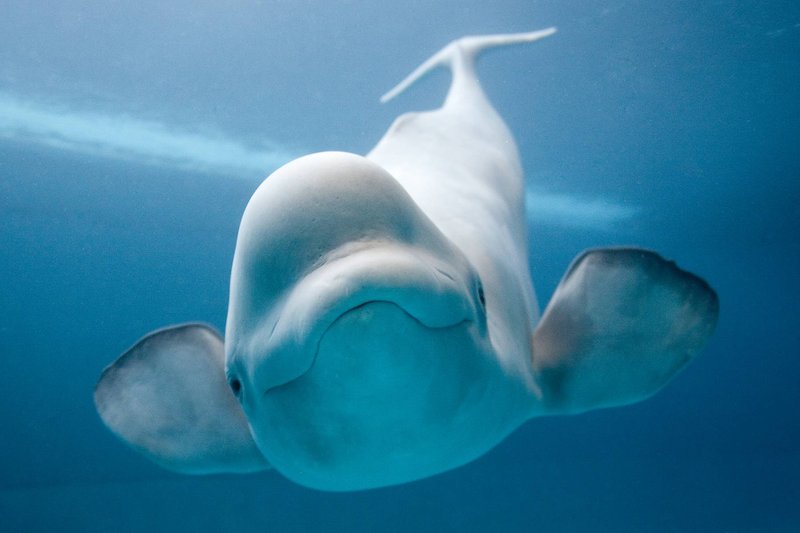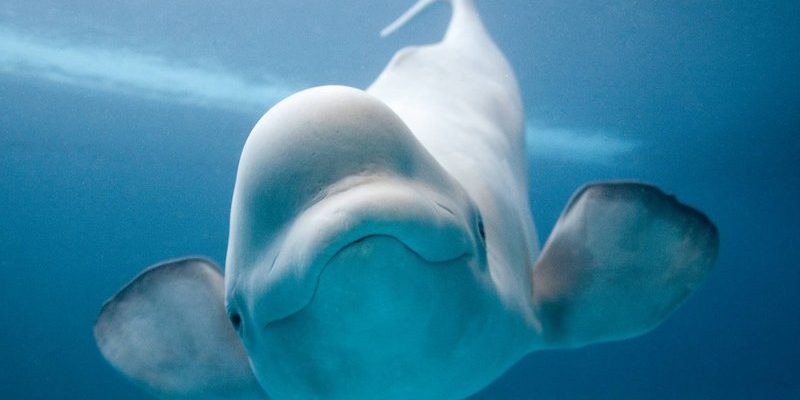
Imagine diving into the ocean with a whole arsenal of tools designed to help you conquer the depths. That’s how beluga whales operate. Their bodies and behaviors have evolved over time to meet the challenges of living in cold, icy waters. From their flexible necks to their unique skin, each feature plays a role in their survival. Let me explain some of these fascinating adaptations that make belugas the successful marine mammals they are.
1. Their Unique Body Shape
Beluga whales have a distinct body shape that sets them apart from other whales. Unlike the long, streamlined bodies of many whales, belugas are more robust and rounded. This rounded shape is not just for show; it serves a purpose. The body design helps them conserve heat in the chilly Arctic waters, making it easier to maintain their body temperature.
Moreover, belugas possess a thick layer of blubber underneath their skin. This blubber can be up to 4 inches thick, acting as insulation to keep them warm in icy conditions. Imagine wrapping yourself in a warm blanket in a cold room—that’s how this blubber helps belugas manage the cold.
2. Flexible Neck
You might be surprised to learn that a lot of whales can’t move their necks. But belugas are special! They have seven cervical vertebrae, just like us humans, which allows them to turn their heads from side to side. This flexibility is pretty handy for spotting prey or navigating around obstacles in the water.
Let’s think about how this plays out daily. For a beluga, being able to look around means they can better find food—like fish and squid—while also being aware of predators. It’s like being in a crowded room; if you can turn your head, you can better see who’s around you!
3. Vocal Abilities
Belugas are renowned for their vocal prowess. These whales communicate with a series of clicks, whistles, and trills, which can travel long distances underwater. Their superior hearing and sophisticated vocal cords allow them to convey messages, maintain social bonds, and even locate food.
Imagine if you could call out to your friends underwater and hear them clearly from a distance. That’s what belugas do! This ability is vital for navigating the dark ocean depths where visibility is low. Their calls create a sort of underwater chatroom, helping them stay connected to their pod.
4. White Skin Camouflage
When beluga whales are born, they have a gray-brown color. But as they grow, they gradually turn completely white. This change is not just for aesthetics; it’s a clever form of camouflage! Their white skin helps them blend into the icy waters and icebergs of the Arctic, making it harder for predators, like orcas, to spot them.
Think about how wearing white in a snowstorm can make you less noticeable. For belugas, their coloring helps them sneak up on prey as well, giving them the upper hand when hunting. Plus, it aids in social bonding within the pod, as they all look similar.
5. Echolocation Skills
Belugas use a method called echolocation to navigate and hunt in the murky waters they often inhabit. By producing sounds and listening for their echoes, they can determine the location, size, and shape of objects around them—even in complete darkness!
Picture yourself in a dark room. If you clap your hands and listen for the sound bouncing back, you can get a sense of how big the room is and where the walls are. Belugas do something similar but use their voices instead. This adaptation is crucial for finding food and avoiding obstacles in their environment.
6. Adaptation to Extreme Conditions
Belugas are perfectly suited for life in the harshest Arctic waters. They can dive to depths of over 2,000 feet in search of food, and they’re even capable of holding their breath for up to 25 minutes! Their bodies are built to withstand cold water temperatures, often below freezing.
Here’s the thing: their blood is rich in oxygen, allowing them to use the stored oxygen efficiently during long dives. Imagine trying to run a marathon while holding your breath; it requires incredible stamina, which belugas have mastered over generations.
7. Social Behavior and Teamwork
Beluga whales are known for their strong social structures. They live in groups called pods, which can include anywhere from just a few whales to several dozen. This social behavior is an adaptation that enhances their survival in a challenging environment. Working together allows them to find food more effectively and protect each other from predators.
You might picture a group of friends sharing tips on the best fishing spots. That’s similar to how a pod of belugas interacts! Their teamwork extends to hunting as well, where they coordinate to herd fish into tight balls, making it easier for everyone to get a meal.
8. Lifelong Learning
Lastly, belugas demonstrate a remarkable ability to learn throughout their lives. Young whales learn essential skills from their mothers, including how to hunt and navigate their icy home. This learning isn’t just a one-time deal; it continues as they interact with other whales in their pod.
Imagine learning new skills from your friends or family over the years. For belugas, passing down knowledge is vital for adapting to changing environments and challenges. This evolution of learning behavior is crucial for their survival as the ocean changes around them.
As we’ve explored, beluga whales are truly remarkable creatures that thrive in their underwater world thanks to a range of unique adaptations. From their specialized body shape to their vocal communication, each trait plays a vital role in ensuring their survival. So next time you think about these “canaries of the sea,” remember the smart strategies they use to navigate life below the surface. It’s a tough world out there, but belugas are more than equipped to handle it!

